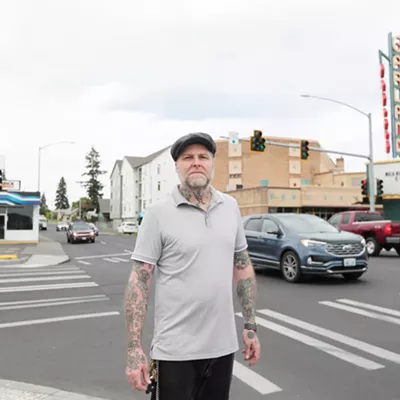It’s a mess inside the Lantern Tavern. The floor’s torn up. A huge cooler sits cockeyed in the middle of everything. There’s dust and dirt and debris.
But change is afoot. Jeff Nordvall and his “partner in everything,” Laura Paisley, have painted the walls a creamy white trimmed with brown. The back-bar shelves are up and handcrafted, hewn from 100-year-old reclaimed barn wood. The tavern, the latest addition in the South Perry district when it opens later this month, is well on its way to great things.
The same can be said of Perry. The past few years have seen the little strip transform itself: The streetscape has been remade, and vintage-like lampposts line the street like warmly glowing sentries. The Hoxsey Block — the main strip of buildings on the street — underwent a facelift with help from the Historic Preservation Office. The foundation is laid. Perry is ready to boom.
So far, the boom has been less like dynamite than a child’s firework. Fits and starts is how most people describe the district’s development. But with the recession at full throttle, it looks like the time for Perry has come. The tavern’s going in, a new restaurant should be open by the end of the year, and one of the district’s largest buildings — which houses Altamont Pharmacy — will soon be empty and ready for new occupants.
“All the groundwork is done,” says Mark Camp, a property owner on the street who has been instrumental in reshaping the district. “I see an ice cream shop or somewhere where you can get a drink and then head down to the Shop and listen to some music. That would be great. That’ll be amazing.”
Clean Slate
In January, Pat Kautzman bought a drab, gray building surrounded by asphalt on the corner of 10th and Perry. “I thought it might be a good investment,” he says. This troublesome economic moment, he continues, allows for some first-rate deals on property. “It’s scary, but there are good values.”
For the past few years, Kautzman’s new purchase had an air more of disuse than potential use. In fact, the previous owner used it as storage space. Kautzman’s plans, however, are far different.
“I’m kicking around some ideas. Something that adds to the neighborhood, where people can gather and meet friends,” he says. It could be a pub or Mexican. Or it could be a pizza joint, which is what most people on the street have heard it’s likely to be. Kautzman won’t commit to any of the ideas, but he does look forward to replacing the two large garage doors with glass and erecting bike racks and dog posts.
He’s excited. By year’s end, he could be hosting an evening hangout for the thousands of neighborhood people who currently have nowhere to go. The nearest place to grab a bite to eat after dark is way up on 29th Avenue. And those living in the neighborhood have big pockets. According to city data, there’s $31 million in consumer cash not being captured within a half-mile of Perry.
For now, Kautzman is busy navigating the city’s bureaucracy. He needs a change-of-use permit and can already see some trouble ahead with his water supply and the city’s request for curb improvements. “The proof will be in the difficulty getting something in here, the amount of energy spent working with the city,” he says. He’s found some help in his course-plotting from the Neighborhood Business Centers (NBC) Program, headed by Teri Cameron Stripes. It’s what NBC does: helps city centers to bloom.
In late 2001, South Perry was ushered into the city’s nascent Centers and Corridors project, along with Hillyard, West Broadway and the Holy Family Employment Center. Aimed at revitalizing promising, if decaying, areas in town, the program connected neighborhoods with grant money and made it easier for businesses to do business: Zoning requirements were changed, incentives were delivered and rules on parking and building placement were lifted.
For Perry, that has meant four years of streetscape construction worth about a million dollars, funded by federal grants, community development block grants and STA funds. With the assistance of the joint city-county Historic Preservation Office, the owner of the Hoxsey Block fixed the façade of the buildings, which date from the early 20th century. Trees were planted, vintage-y lampposts built. Along with these improvements, summertime outdoor films began projecting on an outside wall of the pharmacy, a Thursday farmers market was launched and a huge street fair barricades the street every July.
“The improvement’s immense,” says Geoff White, owner of the Perry Street Café and current chair of Perry’s neighborhood and business association. “It used to be a low-rent type of area. Now, we’re seeing a new era of yuppies. People are buying the old houses here and fixing them up. This area has a real bright feeling.”
The neighborhood is ripe for investment, and the recession is fueling many new business ventures on Perry, Stripes says, as it is in the entire city. “It’s a time of opportunity as well as challenges [and] a lot of people are taking advantage it,” she says. “Maybe they feel if they open in a time of economic recession, things can only get better.”
Right Medicine
Art Tyrell’s moving his pharmacy south, directly into the Safeway on 29th and Southeast Boulevard. He’s getting old and tired of working 12-hour days. That and the grocery giant stepped up the pressure in February to purchase his 99-year-old Perry Street mainstay. “The opportunity came around,” Tyrell says. “You just don’t sell [a pharmacy] like a bottle of aspirin.”
So he’s moving, with an eye on the hardships he avoided: less help from the state on Medicaid payments, and insurance companies “trying to cut what the pay you.” Maybe an increase in rent. And what he’s leaving behind has others dreaming about what’s next.
“I’ve heard people say a sports bar might be nice,” he says. “I’ve heard people say it might be fun to have a movie theater. You could have two pretty good-sized theaters in here... the Perry Street Theater.”
Camp, who owns the building along with the building that houses the Shop, an anchor in the neighborhood, says he’s not quite sure what’s coming for the location. But he has some ideas.
“I want a creative, artistic type of business,” he says. “I don’t want it to be a big chain. … The guys that own the Elk, they own three or four restaurants. That’s cool. I’d like something like that. I don’t want to see a Chili’s.”
Camp doesn’t plan on opening it himself. He just sold the Shop (the business, not the building) last June and keeps busy roasting coffee, small batches called Anvil Coffee. He sees food or a “more significant grocery store that’s not a convenience store,” something similar to Rocket Market. Whatever it is, he says he’ll make sure it doesn’t meddle with any of the neighborhood’s existing businesses.
Mayor Mary Verner, a resident in the Perry neighborhood since 2002, is on board with turning Perry into a thriving, bustling city center that draws people from other parts of town. She says she’d like to see a year-round grocery or somewhere with live music, similar to what the Shop used to host.
“I see [Perry] as a great opportunity site. The core elements are there,” she says. “It’s sometimes harder to make that decision [to open a business] in a recession, it’s a leap of faith. … When I see people making those decisions in this market economy, I have great respect for them.”
So she’ll probably make it down to the Lantern Tavern soon, to show a little respect, drink a pint and leave a buck on the bar. Something for the new barkeep.
For more on this story, visit KXLY.com.






















